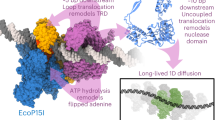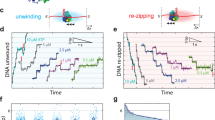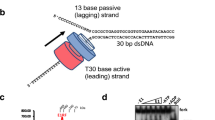Abstract
Helicases are molecular motors that unwind double-stranded DNA or RNA. In addition to unwinding nucleic acids, an important function of these enzymes seems to be the disruption of protein-nucleic acid interactions. Bacteriophage T4 Dda helicase can displace proteins bound to DNA, including streptavidin bound to biotinylated oligonucleotides. We investigated the mechanism of streptavidin displacement by varying the length of the oligonucleotide substrate. We found that a monomeric form of Dda catalyzed streptavidin displacement; however, the activity increased when multiple helicase molecules bound to the biotinylated oligonucleotide. The activity does not result from cooperative binding of Dda to the oligonucleotide. Rather, the increase in activity is a consequence of the directional bias in translocation of individual helicase monomers. Such a bias leads to protein-protein interactions when the lead monomer stalls owing to the presence of the streptavidin block.
This is a preview of subscription content, access via your institution
Access options
Subscribe to this journal
Receive 12 print issues and online access
$189.00 per year
only $15.75 per issue
Buy this article
- Purchase on Springer Link
- Instant access to full article PDF
Prices may be subject to local taxes which are calculated during checkout








Similar content being viewed by others
References
Delagoutte, E. & von Hippel, P.H. Helicase mechanisms and the coupling of helicases within macromolecular machines. Part I: structures and properties of isolated helicases. Q. Rev. Biophys. 35, 431–478 (2002).
Soultanas, P. & Wigley, D.B. Unwinding the 'Gordian knot' of helicase action. Trends Biochem. Sci. 26, 47–54 (2001).
Patel, S.S. & Picha, K.M. Structure and function of hexameric helicases. Annu. Rev. Biochem. 69, 651–697 (2000).
Lohman, T.M. & Bjornson, K.P. Mechanisms of helicase-catalyzed DNA unwinding. Annu. Rev. Biochem. 65, 169–214 (1996).
Patel, S.S. & Hingorani, M.M. Oligomeric structure of bacteriophage T7 DNA primase/helicase proteins. J. Biol. Chem. 268, 10668–10675 (1993).
Dong, F., Gogol, E.P. & von Hippel, P.H. The phage T4-coded DNA replication helicase (gp41) forms a hexamer upon activation by nucleoside triphosphate. J. Biol. Chem. 270, 7462–7473 (1995).
Singleton, M.R., Sawaya, M.R., Ellenberger, T. & Wigley, D.B. Crystal structure of T7 gene 4 ring helicase indicates a mechanism for sequential hydrolysis of nucleotides. Cell 101, 589–600 (2000).
Egelman, E.H., Yu, X., Wild, R., Hingorani, M.M. & Patel, S.S. Bacteriophage T7 helicase/primase proteins form rings around single-stranded DNA that suggest a general structure for hexameric helicases. Proc. Natl. Acad. Sci. USA 92, 3869–3873 (1995).
Morris, P.D. & Raney, K.D. DNA helicases displace streptavidin from biotin-labeled oligonucleotides. Biochemistry 38, 5164–5171 (1999).
Gorbalenya, A. & Koonin, E.V. Helicases: amino acid sequence comparisons and structure-function relationships. Curr. Opin. Struct. Biol. 3, 419–429 (1993).
Mechanic, L.E., Hall, M.C. & Matson, S.W. Escherichia coli DNA helicase II is active as a monomer. J. Biol. Chem. 274, 12488–12498 (1999).
Runyon, G.T., Wong, I. & Lohman, T.M. Overexpression, purification, DNA binding, and dimerization of the Escherichia coli uvrD gene product (helicase II). Biochemistry 32, 602–612 (1993).
Ali, J.A., Maluf, N.K. & Lohman, T.M. An oligomeric form of E. coli UvrD is required for optimal helicase activity. J. Mol. Biol. 293, 815–834 (1999).
Maluf, N.K., Fischer, C.J. & Lohman, T.M. A dimer of Escherichia coli UvrD is the active form of the helicase in vitro. J. Mol. Biol. 325, 913–935 (2003).
Wong, I., Chao, K.L., Bujalowski, W. & Lohman, T.M. DNA-induced dimerization of the Escherichia coli rep helicase. Allosteric effects of single-stranded and duplex DNA. J. Biol. Chem. 267, 7596–7610 (1992).
Korolev, S., Hsieh, J., Gauss, G.H., Lohman, T.M. & Waksman, G. Major domain swiveling revealed by the crystal structures of complexes of E. coli Rep helicase bound to single-stranded DNA and ADP. Cell 90, 635–647 (1997).
Chao, K.L. & Lohman, T.M. DNA-induced dimerization of the Escherichia coli Rep helicase. J. Mol. Biol. 221, 1165–1181 (1991).
Cho, H.S. et al. Crystal structure of RNA helicase from genotype 1b hepatitis C virus. A feasible mechanism of unwinding duplex RNA. J. Biol. Chem. 273, 15045–15052 (1998).
Levin, M.K. & Patel, S.S. The helicase from hepatitis C virus is active as an oligomer. J. Biol. Chem. 274, 31839–31846 (1999).
Velankar, S.S., Soultanas, P., Dillingham, M.S., Subramanya, H.S. & Wigley, D.B. Crystal structures of complexes of PcrA DNA helicase with a DNA substrate indicate an inchworm mechanism. Cell 97, 75–84 (1999).
Kim, J.L. et al. Hepatitis C virus NS3 RNA helicase domain with a bound oligonucleotide: the crystal structure provides insights into the mode of unwinding. Structure, 6, 89–100 (1998).
Jongeneel, C.V., Formosa, T. & Alberts, B.M. Purification and characterization of the bacteriophage T4 Dda protein. J. Biol. Chem. 259, 12925–12932 (1984).
Hacker, K.J. & Alberts, B.M. Overexpression, purification, sequence analysis, and characterization of the T4 bacteriophage Dda DNA helicase. J. Biol. Chem. 267, 20674–20681 (1992).
Raney, K.D. & Benkovic, S.J. Bacteriophage T4 Dda helicase translocates in a unidirectional fashion on single-stranded DNA. J. Biol. Chem. 270, 22236–22242 (1995).
Barry, J. & Alberts, B. A role for two DNA helicases in the replication of T4 bacteriophage DNA. J. Biol. Chem. 269, 33063–33068 (1994).
Gauss, P., Park, K., Spencer, T.E. & Hacker, K.J. DNA helicase requirements for DNA replication during bacteriophage T4 infection. J. Bacteriol. 176, 1667–1672 (1994).
Formosa, T., Burke, R.L. & Alberts, B.M. Affinity purification of bacteriophage T4 proteins essential for DNA replication and genetic recombination. Proc. Natl. Acad. Sci. USA 80, 2442–2446 (1983).
Kodadek, T. & Alberts, B.M. Stimulation of protein-directed strand exchange by a DNA helicase. Nature 326, 312–314 (1987).
Bedinger, P., Hochstrasser, M., Jongeneel, C.V. & Alberts, B.M. Properties of the T4 bacteriophage DNA replication apparatus: the T4 dda DNA helicase is required to pass a bound RNA polymerase molecule. Cell 34, 115–123 (1983).
Jongeneel, C.V., Bedinger, P. & Alberts, B.M. Effects of the bacteriophage T4 Dda protein on DNA synthesis catalyzed by purified T4 replication proteins. J. Biol. Chem. 259, 12933–12938 (1984).
Morris, P.D. et al. Evidence for a functional monomeric form of the bacteriophage T4 DdA helicase. Dda does not form stable oligomeric structures. J. Biol. Chem. 276, 19691–19698 (2001).
Nanduri, B., Byrd, A.K., Eoff, R.L., Tackett, A.J. & Raney, K.D. Pre-steady-state DNA unwinding by bacteriophage T4 Dda helicase reveals a monomeric molecular motor. Proc. Natl. Acad. Sci. USA 99, 14722–14727 (2002).
Eggleston, A.K., O'Neill, T.E., Bradbury, E.M. & Kowalczykowski, S.C. Unwinding of nucleosomal DNA by a DNA helicase. J. Biol. Chem. 270, 2024–2031 (1995).
Krejci, L. et al. DNA helicase Srs2 disrupts the Rad51 presynaptic filament. Nature 423, 305–309 (2003).
Veaute, X. et al. The Srs2 helicase prevents recombination by disrupting Rad51 nucleoprotein filaments. Nature 423, 309–312 (2003).
Kodadek, T. Inhibition of protein-mediated homologous pairing by a DNA helicase. J. Biol. Chem. 266, 9712–9718 (1991).
Morris, P.D., Tackett, A.J. & Raney, K.D. Biotin-streptavidin-labeled oligonucleotides as probes of helicase mechanisms. Methods 23, 149–159 (2001).
Yancey-Wrona, J.E. & Matson, S.W. Bound Lac repressor protein differentially inhibits the unwinding reactions catalyzed by DNA helicases. Nucleic Acids Res. 20, 6713–6721 (1992).
Jankowsky, E., Gross, C.H., Shuman, S. & Pyle, A.M. Active disruption of an RNA-protein interaction by a DExH/D RNA helicase. Science 291, 121–125 (2001).
Kowalczykowski, S.C. et al. Cooperative and noncooperative binding of protein ligands to nucleic acid lattices: experimental approaches to the determination of thermodynamic parameters. Biochemistry 25, 1226–1240 (1986).
Kuzmic, P. Program DYNAFIT for the analysis of enzyme kinetic data: application to HIV proteinase. Anal. Biochem. 237, 260–273 (1996).
Gilbert, S.P. & Mackey, A.T. Kinetics: a tool to study molecular motors. Methods 22, 337–354 (2000).
Mackey, A.T. & Gilbert, S.P. Moving a microtubule may require two heads: a kinetic investigation of monomeric Ncd. Biochemistry 39, 1346–1355 (2000).
Vilfan, A. et al. Dynamics and cooperativity of microtubule decoration by the motor protein kinesin. J. Mol. Biol. 312, 1011–1026 (2001).
Endow, S.A. & Higuchi, H. A mutant of the motor protein kinesin that moves in both directions on microtubules. Nature 406, 913–916 (2000).
Badoual, M., Julicher, F. & Prost, J. Bidirectional cooperative motion of molecular motors. Proc. Natl. Acad. Sci. USA 99, 6696–6701 (2002).
Smith, D.E. et al. The bacteriophage straight φ29 portal motor can package DNA against a large internal force. Nature 413, 748–752 (2001).
Yodh, J.G. & Bryant, F.R. Kinetics of ATP hydrolysis during the DNA helicase II-promoted unwinding of duplex DNA. Biochemistry 32, 7765–7771 (1993).
Carroll, S.S., Benseler, F. & Olsen, D.B. Preparation and use of synthetic oligoribonucleotides as tools for study of viral polymerases. Methods Enzymol. 275, 365–382 (1996).
Levin, M.K., Wang, Y.-H. & Patel, S.S. The functional interaction of the hepatitis C virus helicase molecules is responsible for unwinding processivity. J. Biol. Chem. Epub ahead of print, 14 April 2004 (doi:10.1074/jbc.M403257200)
Acknowledgements
This work was supported by research grant GM59400 (K.D.R) from the US National Institutes of Health (NIH) and the University of Arkansas for Medical Sciences graduate student research fund (A.K.B.). Core lab support for DNA synthesis and characterization was provided by NIH COBRE grant P20 RR15569. We thank C. Cameron for careful reading of the manuscript and R. Eoff for assistance with the stopped-flow experiments.
Author information
Authors and Affiliations
Corresponding author
Ethics declarations
Competing interests
The authors declare no competing financial interests.
Rights and permissions
About this article
Cite this article
Byrd, A., Raney, K. Protein displacement by an assembly of helicase molecules aligned along single-stranded DNA. Nat Struct Mol Biol 11, 531–538 (2004). https://doi.org/10.1038/nsmb774
Received:
Accepted:
Published:
Issue Date:
DOI: https://doi.org/10.1038/nsmb774
This article is cited by
-
Enzyme-free targeted DNA demethylation using CRISPR–dCas9-based steric hindrance to identify DNA methylation marks causal to altered gene expression
Nature Protocols (2022)
-
The RSC chromatin remodelling ATPase translocates DNA with high force and small step size
The EMBO Journal (2011)
-
Branch migration enzyme as a Brownian ratchet
The EMBO Journal (2008)
-
Helicase translocation assay method using avidin and biotinylated nucleotides
Biotechnology Letters (2008)
-
The DEAD-box protein Ded1 unwinds RNA duplexes by a mode distinct from translocating helicases
Nature Structural & Molecular Biology (2006)



